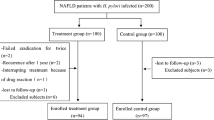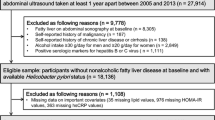Abstract
Purpose of Review
Helicobacter pylori (HP) infection is known to be a significant risk factor in the development of certain gastric conditions, such as ulcers, gastritis, and malignancy. Recently, however, the systemic effect of HP infection on other organ systems has come to be appreciated. In this review, we will explore the association between HP infection and nonalcoholic fatty liver disease (NAFLD), the hepatic component of metabolic syndrome.
Recent Findings
The possible association between HP infection and NAFLD initially stemmed from the isolation of HP bacteria in the livers of patients with NAFLD. Although there have been conflicting results, several subsequent clinical trials have demonstrated a higher rate of fatty liver and NASH in HP-positive patients compared to HP-negative patients; in addition, small trials examining the effect of HP eradication have shown improvement in markers of NAFLD activity, further supporting a link between these two conditions. The pathophysiology behind the possible association between HP infection and NAFLD has yet to be fully elucidated; several possible mechanisms include induction of a pro-inflammatory state that shifts the body toward a more lipogenic profile, and a hormonal shift that favors progression toward insulin resistance and fibrosis.
Summary
The association between HP infection and NAFLD has been demonstrated in several clinical trials, including small trials evaluating the effect of HP eradication on NAFLD. Future studies examining the pathophysiology behind this association are the next step in characterizing the relationship between these two conditions.
Similar content being viewed by others
References
Papers of particular interest, published recently, have been highlighted as: • Of importance
Eslick GD et al. Association of Helicobacter pylori infection with gastric carcinoma: a meta-analysis. Am J Gastroenterol. 1999;94(9):2373–9.
NIH Consensus Conference. Helicobacter pylori in peptic ulcer disease. NIH Consensus Development Panel on Helicobacter pylori in Peptic Ulcer Disease. JAMA 1994; 272(1):65-9
Rocha GA et al. Helicobacter pylori acute gastritis: histological, endoscopical, clinical, and therapeutic features. Am J Gastroenterol. 1991;86(11):1592–5.
Marshall BJ, Warren JR. Unidentified curved bacilli in the stomach of patients with gastritis and peptic ulceration. Lancet. 1984;1(8390):1311–5.
Schistosomes, liver flukes and Helicobacter pylori. IARC Working Group on the Evaluation of Carcinogenic Risks to Humans. Lyon, 7-14 June 1994. IARC Monogr Eval Carcinog Risks Hum 1994; 61:1-241.
Huang JQ et al. Meta-analysis of the relationship between Helicobacter pylori seropositivity and gastric cancer. Gastroenterology. 1998;114(6):1169–79.
Fashner J, Gitu AC. Diagnosis and treatment of peptic ulcer disease and H. pylori infection. Am Fam Physician. 2015;91(4):236–42.
Chey WD, Wong BC, Practice Parameters Committee of the American College of Gastroenterology. American College of Gastroenterology guideline on the management of Helicobacter pylori infection. Am J Gastroenterol. 2007;102(8):1808–25.
Wong RJ et al. Nonalcoholic steatohepatitis is the second leading etiology of liver disease among adults awaiting liver transplantation in the United States. Gastroenterology. 2015;148(3):547–55.
Chalasani N et al. The diagnosis and management of non-alcoholic fatty liver disease: practice guideline by the American Gastroenterological Association, American Association for the Study of Liver Diseases, and American College of Gastroenterology. Gastroenterology. 2012;142(7):1592–609.
Dixon JB et al. Nonalcoholic fatty liver disease: improvement in liver histological analysis with weight loss. Hepatology. 2004;39(6):1647–54.
Promrat K et al. Randomized controlled trial testing the effects of weight loss on nonalcoholic steatohepatitis. Hepatology. 2010;51(1):121–9.
Keating SE et al. Exercise and non-alcoholic fatty liver disease: a systematic review and meta-analysis. J Hepatol. 2012;57(1):157–66.
Sonnenberg A, Genta RM. Helicobacter pylori is a risk factor for colonic neoplasms. Am J Gastroenterol. 2013;108(2):208–15.
Zhao YS et al. Meta-analysis of different test indicators: Helicobacter pylori infection and the risk of colorectal cancer. Int J Colorectal Dis. 2008;23(9):875–82.
Zumkeller N et al. Helicobacter pylori infection and colorectal cancer risk: a meta-analysis. Helicobacter. 2006;11(2):75–80.
Franceschi F et al. Clinical effects of Helicobacter pylori outside the stomach. Nat Rev Gastroenterol Hepatol. 2014;11(4):234–42.
Arnold DM et al. Platelet count response to H. pylori treatment in patients with immune thrombocytopenic purpura with and without H. pylori infection: a systematic review. Haematologica. 2009;94(6):850–6.
Kaptan K et al. Helicobacter pylori—is it a novel causative agent in vitamin B12 deficiency? Arch Intern Med. 2000;160(9):1349–53.
Qu XH et al. Does Helicobacter pylori infection play a role in iron deficiency anemia? A meta-analysis. World J Gastroenterol. 2010;16(7):886–96.
Cindoruk M et al. Identification of Helicobacter species by 16S rDNA PCR and sequence analysis in human liver samples from patients with various etiologies of benign liver diseases. Eur J Gastroenterol Hepatol. 2008;20(1):33–6.
Pirouz T et al. Detection of Helicobacter pylori in paraffin-embedded specimens from patients with chronic liver diseases, using the amplification method. Dig Dis Sci. 2009;54(7):1456–9.
• Polyzos SA et al. Helicobacter pylori infection in patients with nonalcoholic fatty liver disease. Metabolism. 2013;62(1):121–6. Higher rates of anti-HP IgG are present in patients with NAFLD, HP infection is an independent predictor of NALFD. and HP-positive patients have lower adiponectin rates.
Goo MJ et al. Helicobacter pylori promotes hepatic fibrosis in the animal model. Lab Invest. 2009;89(11):1291–303.
Dogan Z et al. Association between Helicobacter pylori and liver-to-spleen ratio: a randomized-controlled single-blind study. Eur J Gastroenterol Hepatol. 2013;25(1):107–10.
• Sumida Y et al. Helicobacter pylori infection might have a potential role in hepatocyte ballooning in nonalcoholic fatty liver disease. J Gastroenterol. 2015;50:996–1004. HP infection is an independent predictor of NASH; HP-positive patients also have a higher grade of hepatocyte ballooning.
Okushin K et al. Helicobacter pylori infection is not associated with fatty liver disease including non-alcoholic fatty liver disease: a large-scale cross-sectional study in Japan. BMC Gastroenterol. 2015;15:25.
Baeg MK et al. Helicobacter pylori infection is not associated with nonalcoholic fatty liver disease. World J Gastroenterol. 2016;22(8):2592–600.
• Polyzos SA et al. Effect of Helicobacter pylori eradication on hepatic steatosis, NAFLD fibrosis score and HSENSI in patients with nonalcoholic steatohepatitis: a MR imaging-based pilot open-label study. Arq Gastroenterol. 2014;51(3):261–8. HP eradication leads to improvement in markers of NAFLD activity and NAFLD fibrosis score.
• Jamali R et al. The effect of helicobacter pylori eradication on liver fat content in subjects with non-alcoholic fatty liver disease: a randomized open-label clinical trial. Hepat Mon. 2013;13(12):e14679. HP eradication leads to a substantial decrease in mean liver fat content, though this was not evaluated statistically.
Li M, Shen Z, Li YM. Potential role of Helicobacter pylori infection in nonalcoholic fatty liver disease. World J Gastroenterol. 2013;19(41):7024–31.
Satoh H et al. Helicobacter pylori infection is a significant risk for modified lipid profile in Japanese male subjects. J Atheroscler Thromb. 2010;17(10):1041–8.
Peek Jr RM, Blaser MJ. Helicobacter pylori and gastrointestinal tract adenocarcinomas. Nat Rev Cancer. 2002;2(1):28–37.
Basso D, Plebani M, Kusters JG. Pathogenesis of Helicobacter pylori infection. Helicobacter. 2010;15 Suppl 1:14–20.
Hui JM et al. Beyond insulin resistance in NASH: TNF-alpha or adiponectin? Hepatology. 2004;40(1):46–54.
Feinstein R et al. Tumor necrosis factor-alpha suppresses insulin-induced tyrosine phosphorylation of insulin receptor and its substrates. J Biol Chem. 1993;268(35):26055–8.
Hotamisligil GS, Shargill NS, Spiegelman BM. Adipose expression of tumor necrosis factor-alpha: direct role in obesity-linked insulin resistance. Science. 1993;259(5091):87–91.
Rolo AP, Teodoro JS, Palmeira CM. Role of oxidative stress in the pathogenesis of nonalcoholic steatohepatitis. Free Radic Biol Med. 2012;52(1):59–69.
Ibrahim SH, Kohli R, Gores GJ. Mechanisms of lipotoxicity in NAFLD and clinical implications. J Pediatr Gastroenterol Nutr. 2011;53(2):131–40.
Buechler C, Wanninger J, Neumeier M. Adiponectin, a key adipokine in obesity related liver diseases. World J Gastroenterol. 2011;17(23):2801–11.
Savvidou S et al. Low serum adiponectin levels are predictive of advanced hepatic fibrosis in patients with NAFLD. J Clin Gastroenterol. 2009;43(8):765–72.
• Ando T et al. Impact of Helicobacter pylori eradication on circulating adiponectin in humans. Helicobacter. 2013;18(2):158–64. HP eradication leads to increase in adiponectin levels.
Ismail NA et al. Fetuin-A levels in obesity: differences in relation to metabolic syndrome and correlation with clinical and laboratory variables. Arch Med Sci. 2012;8(5):826–33.
Tonjes A, Bluher M, Stumvoll M. Retinol-binding protein 4 and new adipocytokines in nonalcoholic fatty liver disease. Curr Pharm Des. 2010;16(17):1921–8.
• Manolakis AC et al. Increased fetuin A levels in Helicobacter pylori infection: a missing link between H. pylori and insulin resistance? Diabetologia. 2011;54(2):472–4. Fetuin-A levels are significantly higher in HP-positive patients.
Kebapcilar L et al. The effect of Helicobacter pylori eradication on macrophage migration inhibitory factor, C-reactive protein and fetuin-a levels. Clinics (Sao Paulo). 2010;65(8):799–802.
Author information
Authors and Affiliations
Corresponding author
Ethics declarations
Conflict of Interest
Sheila Kumar and Derek M. Tang declare no conflict of interest.
Human and Animal Rights and Informed Consent
This article does not contain any studies with human or animal subjects performed by any of the authors.
Additional information
This article is part of the Topical Collection on Stomach and Duodenum
Rights and permissions
About this article
Cite this article
Tang, D.M., Kumar, S. The Association Between Helicobacter pylori Infection and Nonalcoholic Fatty Liver Disease. Curr Gastroenterol Rep 19, 5 (2017). https://doi.org/10.1007/s11894-017-0545-1
Published:
DOI: https://doi.org/10.1007/s11894-017-0545-1




